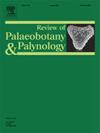文章标题辽西中侏罗统针蕨属一新种宏观形态和孢子形态研究
IF 1.7
3区 地球科学
Q2 PALEONTOLOGY
引用次数: 0
摘要
Coniopteris Brong。修订。Harris, 1961是一个丰富多样的中生代蕨类植物分类群,通常被解释为双子叶蕨。它可能起源于晚三叠世,分别在中侏罗世和早白垩世两次繁荣,在早白垩世晚期后逐渐消失。在世界范围内,已有80余种归为锥虫属,其中至少65种曾在中国被发现。本文根据辽西北票市中侏罗统海方沟组保存完好的可育孢子叶,描述了一新种Coniopteris hafanggouensis sp. nov.。叶子至少是双翅状的。可育的羽片披针形,交替排列于轴上,叶面退化为一柄,顶端有长椭圆形或圆形的茎。初步认为海方沟杉叶型为二形型。孢子呈圆形四面体,表面呈颗粒状或皱褶状,有长而直的三辐射状裂缝。与保存在海坊沟组的分散孢子相比,C. haifanggouensis原位孢子在大体形态和微观结构细节上与Deltoidospora magna最相似。这一发现丰富了中国刺蕨属植物的物种多样性,为进一步了解刺蕨属植物的原位孢子和叶型特征提供了新的证据。本文章由计算机程序翻译,如有差异,请以英文原文为准。
Study on macro- and sporemorphology of a new species of Coniopteris (Dicksoniaceae) from the Middle Jurassic of western Liaoning, Northeast China
Coniopteris Brong. emend. Harris, 1961 is an abundant and diverse fern taxon during the Mesozoic period, and it is commonly interpreted as a dicksoniaceous fern. With a probably Late Triassic origin, it flourished twice, in the Middle Jurassic and Early Cretaceous, respectively, then gradually disappeared after the late Early Cretaceous. Over 80 species have been ascribed to Coniopteris worldwide, of which at least 65 species were once found in China. In this paper, a new species, Coniopteris haifanggouensis sp. nov., is described, based on a well-preserved fertile frond with in-situ spores from the Middle Jurassic Haifanggou Formation in Beipiao City, western Liaoning Province, Northeast China. The frond is at least bipinnate. The fertile pinnae are lanceolate in shape, alternately arranged on the rachis, and the laminae are reduced to a stalk bearing long elliptical or rounded sorus at the tip. It is tentatively proposed that the frond type of C. haifanggouensis should be dimorphic. The spores are rounded-tetrahedral, with granular or wrinkled surfaces, and long and straight triradiate cracks. Compared to the dispersed spores preserved in the Haifanggou Formation, the in-situ spores of C. haifanggouensis are most similar to Deltoidospora magna in both gross morphology and microstructural details. The present finding enriches the species diversity of Coniopteris in China, and provides new evidence for further understanding of the characteristic of in-situ spores and frond types of the genus.
求助全文
通过发布文献求助,成功后即可免费获取论文全文。
去求助
来源期刊
CiteScore
3.50
自引率
21.10%
发文量
149
审稿时长
6 months
期刊介绍:
The Review of Palaeobotany and Palynology is an international journal for articles in all fields of palaeobotany and palynology dealing with all groups, ranging from marine palynomorphs to higher land plants. Original contributions and comprehensive review papers should appeal to an international audience. Typical topics include but are not restricted to systematics, evolution, palaeobiology, palaeoecology, biostratigraphy, biochronology, palaeoclimatology, paleogeography, taphonomy, palaeoenvironmental reconstructions, vegetation history, and practical applications of palaeobotany and palynology, e.g. in coal and petroleum geology and archaeology. The journal especially encourages the publication of articles in which palaeobotany and palynology are applied for solving fundamental geological and biological problems as well as innovative and interdisciplinary approaches.

 求助内容:
求助内容: 应助结果提醒方式:
应助结果提醒方式:


